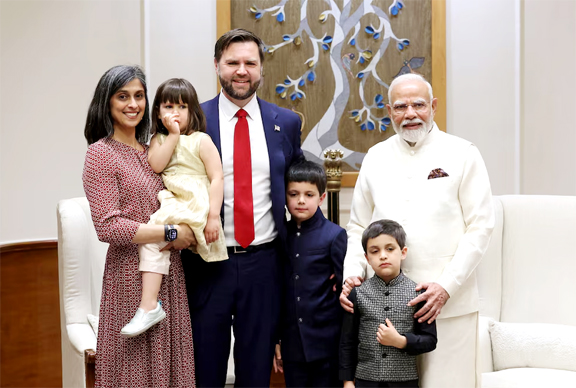DE News Desk :
US Vice President JD Vance and Indian Prime Minister Narendra Modi have welcomed what both sides described as “significant progress” in negotiations for an early trade agreement between the two nations, as New Delhi looks to avert looming US tariffs and strengthen economic ties with the Trump administration.
Vance arrived in India on Monday for a four-day visit with his family, combining official engagements with personal travel.
His itinerary includes visits to the Taj Mahal and a keynote speech in Jaipur, according to US officials.
Following their meeting, Prime Minister Modi’s office issued a statement noting the leaders’ shared commitment to deepening collaboration across multiple domains, including energy, defence, and strategic technologies.
The two also exchanged views on key regional and global developments, reaffirming their support for dialogue and diplomacy—India’s consistent stance in ongoing international conflicts, including the war in Ukraine.
Modi conveyed his greetings to President Donald Trump and said he looked forward to welcoming him to India later this year, the statement added.
A corresponding release from Vance’s office confirmed that both leaders had agreed on a roadmap for advancing trade talks.
It described the potential bilateral trade deal as “an opportunity to forge a modern agreement that promotes job creation and enhances the well-being of citizens in both countries.”
Vance’s visit follows a stop in Rome, where he met privately with Pope Francis on Easter Sunday. His wife, Usha Vance, is the daughter of Indian immigrants.
The two leaders also reviewed progress on commitments made during Modi’s February visit to Washington, particularly in areas such as trade fairness and defence cooperation.
Push for a Deal with India’s Top Trading Partner
India is aiming to finalize the initial phase of the trade deal by this autumn, Finance Minister Nirmala Sitharaman said in San Francisco on Monday.
Her remarks came as she began a US tour focused on strengthening bilateral economic ties.
“The objective of this engagement goes beyond reciprocal tariff concerns—it’s about cementing our relationship with our largest trading partner,” Sitharaman said while addressing the Indian diaspora.
The US remains India’s largest trading partner, with bilateral trade reaching $129 billion in 2024. Of that, India posted a surplus of $45.7 billion, according to US government data.
While the Trump administration has criticized India in the past as a “tariff abuser,” New Delhi has shown willingness to reduce import duties on over half its US imports—worth $41.8 billion in 2024—as part of the broader deal.
Indian officials are hopeful of securing the agreement during the 90-day window on tariff hikes announced by Trump on April 9, which temporarily shields key US trading partners, including India, from higher duties.
Foreign ministry spokesperson Randhir Jaiswal said, “We are very positive that this visit will give a further boost to our bilateral ties,” in a briefing last week.
Vance’s trip is also seen as a precursor to President Trump’s planned visit to India later this year for the Quad summit, which will bring together leaders from India, the US, Japan, and Australia.
“The timing of Vice President Vance’s visit is crucial, especially with trade talks accelerating and US-China tensions escalating,” said Harsh Pant, head of strategic studies at the Observer Research Foundation.
“His rising profile in American diplomacy adds another layer of importance to this visit.”

